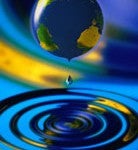 The world is running out of the fresh water needed to grow food and to provide the raw materials business needs to remain productive. The crisis is real and growing, yet remains largely hidden behind policies that have kept water relatively cheap. But this papering over of the cracks is beginning to wear thin.
The world is running out of the fresh water needed to grow food and to provide the raw materials business needs to remain productive. The crisis is real and growing, yet remains largely hidden behind policies that have kept water relatively cheap. But this papering over of the cracks is beginning to wear thin.
According to a report by the 2030 Water Resources Group (“Charting Our Water Future”), just 20 years from now, global water requirements will be “a full 40% above the current accessible, reliable supply.”
One implication: “Companies that use water irresponsibly or pollute water sources will come under increasing attacks from the public and civil society,” noted a recent editorial in the Financial Times by Ran Sanghera of EIRIS, a not-for-profit provider of research on corporate environmental performance. Expect concerns about corporate reputations regarding water scarcity and water pollution to lead increasingly to “tougher regulation to protect water quality and caps on how much water businesses can withdraw, potentially limiting licenses to operate.”
Sanghera says that the era of cheap water for companies is ending, and that supply chains can be highly dependent on water resources, “which means the risks from water scarcity can be spread across the entire value chain.”
We’ve all seen the stories of rising global food prices, partly a result of severe heat and a drought last summer in Russia, the Ukraine and Kazakhstan. It will take time to determine whether the extreme weather there resulted from climate change as some observers contend, but one clear lesson, based on the spike in food prices, is just how much impact a water shortage can have.
With all of this comes a growing awareness about the value of water. But whether that awareness is spreading fast enough remains an open question. The use of fresh water has more than doubled over the past 50 years, and many fear that we are coming close to a frightening breaking point, a world where chronic water shortages for farmers, businesses and people is the norm. Some experts even see international conflict emerging over access to dwindling supplies.
Some progressive high-volume corporate users of water understand these issues and are “doing good work, sometimes even more than the governments in host countries where the plants operate,” says Stanley L. Laskowski, a lecturer at the University of Pennsylvania. Robert Giegengack, professor emeritus in the department of earth and environmental science at the University of Pennsylvania and also a faculty member of the Initiative for Global Environmental Leadership at Penn/Wharton (IGEL), agrees: “Corporations are starting to get it” when it comes to water conservation.
But while some of their objectives, such as being “water neutral” and using “footprinting” — tracking water use through the supply chain — are ambitious, what is being done to achieve them? Are these goals realistic, and will they have enough impact?
Knowledge at Wharton, in cooperation with IGEL, recently released a special report that addresses these questions: “Valuing Water: How Can Businesses Manage the Coming Scarcity?”



